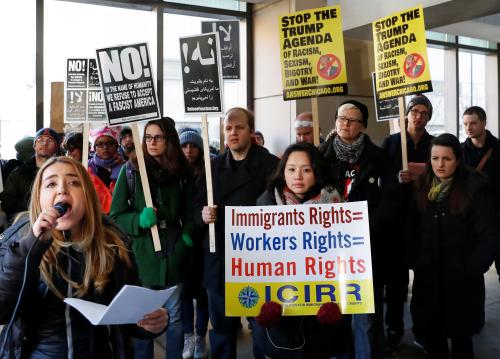EXECUTIVE SUMMARY
Lost in discussions of the military surge, the pace of troop drawdowns, and political benchmarks are millions of displaced Iraqi women, children, and men. Their plight is both a humanitarian tragedy and a strategic crisis that is not being addressed. The massive Iraqi displacement is like the proverbial elephant in the room: U.S. administration officials may acknowledge it as an important issue but lack a serious long-term plan to address the crisis. There is a risk that ignoring this humanitarian dimension will be yet another in a series of strategic blunders by the U.S. government with far-reaching political consequences. After all, the displacement of less than a million Palestinians from Israel in 1948 was initially seen as a temporary humanitarian problem, requiring temporary humanitarian solutions. Today it is hard to imagine the Middle East without the Palestinian diaspora. Present and future Iraqi displacement has the potential to change the Middle East landscape in unpredictably adverse ways. But if thoughtful policymakers—in the U.S. government, the U.N. system, and the non-governmental world—do not think strategically about Iraqi displacement, the implications for security in the region could be equally far-reaching.
The emergency is remarkable from a global perspective as well, as it represents one of the world’s most urgent crises—albeit one that is frequently overlooked. If a similar percentage of the U.S. population were displaced, this would represent over 50 million Americans—the equivalent in displacement of those uprooted by 50 Hurricane Katrinas. The U.N. Undersecretary for Humanitarian Affairs and Relief Coordinator, John Holmes, noted recently, “What may surprise some of you is that the number of displaced in Darfur is comparable to the number of internally displaced people in Iraq. While many are aware of the suffering of civilians in Darfur, it saddens me to see that the daily threats faced by Iraqis, exacerbated, of course, by the ongoing violence, are still under-reported and under-estimated.”1 A report from Oxfam and NCCI released in July 2007 revealed staggering figures: eight million Iraqis in need of immediate humanitarian assistance including four million food-insecure.2
In the mainstream public debates over the Iraq war, far too little attention has focused on the humanitarian crisis. This may be because the Iraqi victims are largely invisible to Western media. While nightly U.S. newscasts highlight the number of casualties among U.S. troops, they rarely mention the number of Iraqis killed or maimed, except for occasional reports of death tolls at the hands of large-scale attacks. Rarely, if ever, do they mention such disparate issues as the massive brain drain that has taken place in Iraq, the staggeringly high unemployment rates, or the growing destitution of Iraqi refugees in Syria. These are not just humanitarian concerns. They are strategic concerns of the highest order. Few in positions of power are giving displacement issues the attention they deserve.
This report analyzes the political dimensions of Iraqi displacement, beginning with a short description of the present situation and its historical background. It then analyzes the implications of the large-scale internal displacement on the security of both Iraq and its two neighbors who host the largest number of Iraqi refugees. A discussion of U.S. policy, European concerns, and the response of the United Nations is followed by analysis of returns of the displaced, with particular attention to the burning issue of property compensation. The study concludes with recommendations to the U.S. government and to the broader international community.
Displacement is not new in Iraq. In fact, the Saddam Hussein regime used forced displacement as a way of strengthening control over the country; by the time of the U.S.-led invasion in March 2003, there were around one million Iraqis who were internally displaced and another 400,000 or so living in refugee-like conditions in other countries. This history of displacement has influenced patterns of current displacement and has led to complicated territorial disputes and property claims. In conflict-prone areas, such as the Turkish-Iraqi border, the country’s disputed territories (e.g. Kirkuk), Baghdad, and Basra, among others, there is the potential for even more displacement.
Iraq’s displacement crisis is massive; according to the best estimates, the number approaches two million refugees and 2.7 million internally displaced persons (IDPs). Although the pace of displacements has slowed in the las six months, few IDPs and refugees have been able to return, their resources are running out and international assistance has been inadequate. In Iraq and neighboring host countries, displaced families blend into urban landscapes, making them less visible than refugees living in overcrowded camps. The delivery of humanitarian aid to this urban population has been difficult—and, in the case of Iraq, very dangerous.
Displacement is not just an accidental by-product of the conflict, but is both an objective and a strategy in the armed struggle—a way of consolidating territorial and political control. Displacement by “ethnic cleansing” is changing—perhaps permanently—Iraq’s sectarian geography with clear consequences for the country’s eventual political reconciliation and stability. Iraq’s Ambassador to the U.S. has called the refugee flows to neighboring countries a flight of “moderation”.3 Iraqi families, many of them educated members of the middle-class, have fled the sectarian conflict, refusing to join in or become exterminated by groups touting extremist views. These moderate families, he hopes, will return to the country. If solutions aren’t found for Iraq’s refugees and internally displaced, there can be no peace in Iraq.
No government in the region—or indeed in the world—wants Iraqi refugees. Jordan and Syria, which together host the largest number of Iraqis, have virtually closed their borders to Iraqis seeking safety. In both countries, there are concerns about the social impact and economic costs of the presence of the refugees (although they are not recognized as refugees). Both governments are also worried about the security implications of hosting so many Iraqis. Reports of increasing destitution among the refugees are linked to fears that desperate men may join insurgent groups, just as desperate women are increasingly turning to prostitution. Given the region’s experience in hosting Palestinian refugees for 60+ years, there are fears that the displacement of Iraqis could be a protracted one with the potential of de-stabilizing governments. If the refugees were to return too soon or en masse, they would be a de-stabilizing force for Iraq, particularly given the tremendous potential for conflicts over property. If refugees cannot return to their homes, they will either join the ranks of the internally displaced or try to return to exile. Neither solution bodes well for Iraq.
Addressing Iraq’s displacement crisis is not just a question of compassion but a fundamental security issue—security for Iraq, for the countries in the region, and for the United States. Long-term planning should be a priority, as the humanitarian catastrophe will not dissolve on its own. And contingency planning is needed for possible reversals in security gains.
Notes
1
Opening Remarks by Sir John Holmes, Under-Secretary General for Humanitarian Affairs and Emergency Relief Coordinator at the DIHAD 2008 Conference, UN OCHA April 8, 2008. http://www.reliefweb.int/rw/RWB.NSF/db900SID/YSAR-7DHL88?OpenDocument
2
Oxfam, NCCI, “Rising to the Humanitarian Challenge in Iraq,” Briefing Paper No. 105. http://web.mit.edu/humancostiraq/reports/oxfam_iraq.pdf
3
Samir Shakir Mahmood Sumaida’ie, Ambassador of Iraq to the United States of America at the Woodrow Wilson Center, April 9, 2008. http://www.wilsoncenter.org/index.cfm?fuseaction=events.event_summary&event_id=400820



